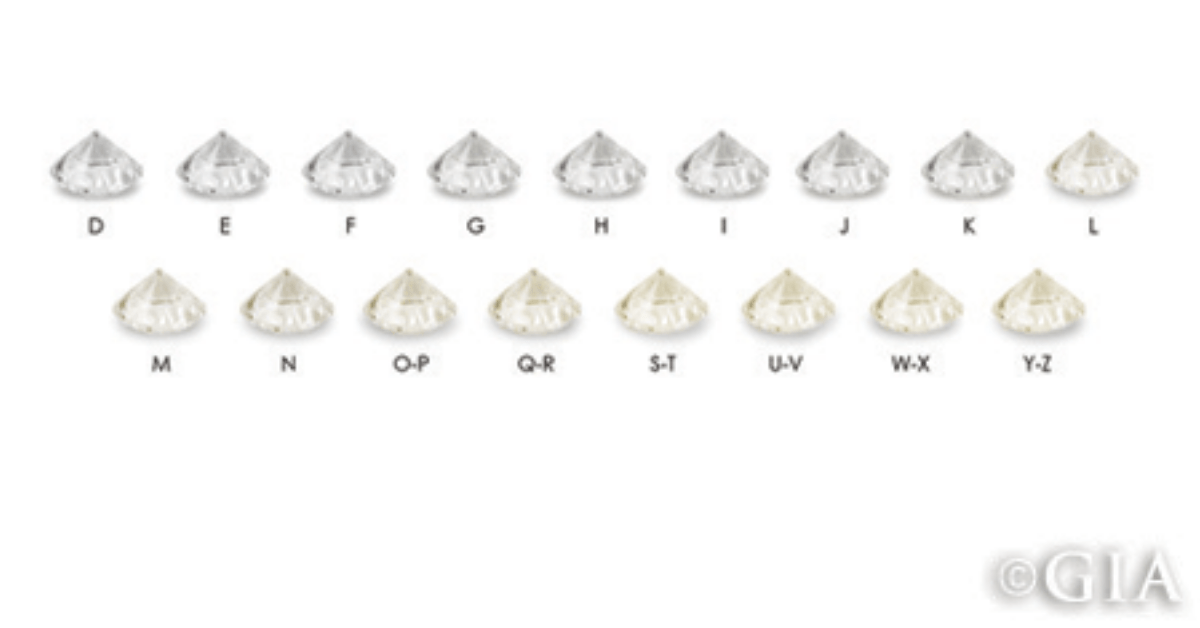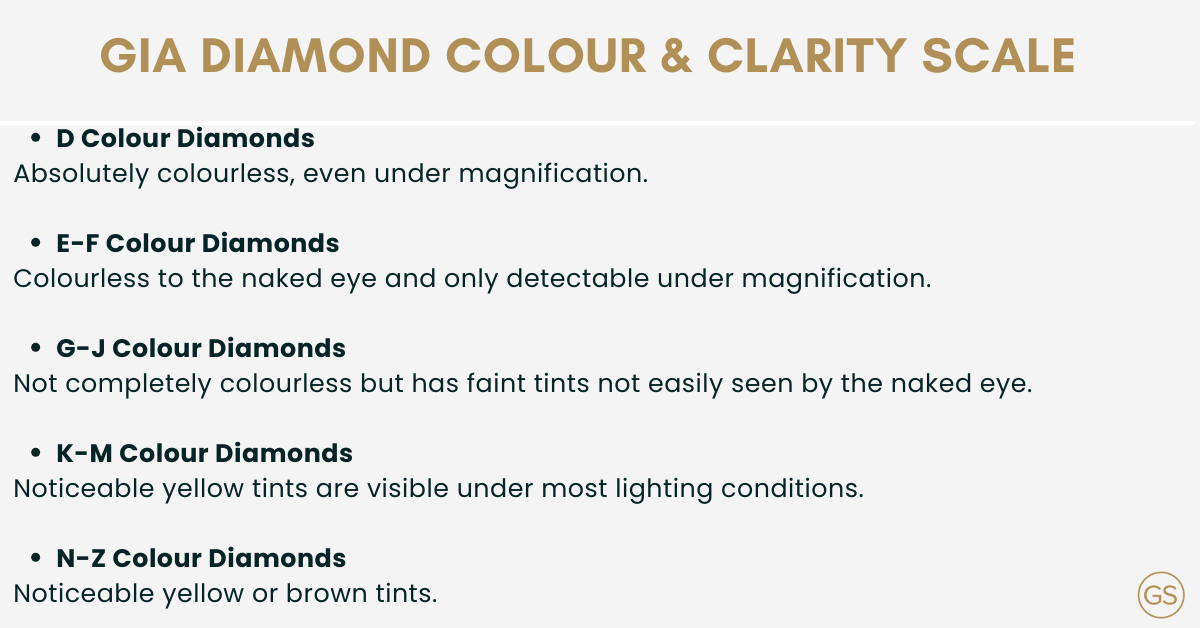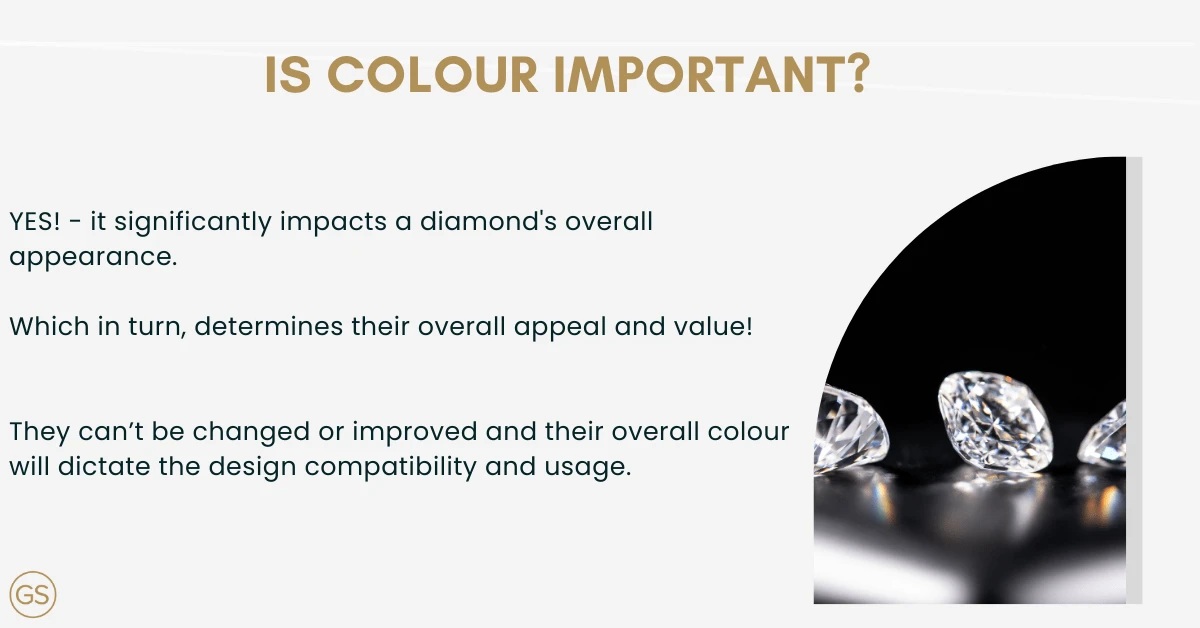
Colour is one of the 4Cs — the main factors to consider when it comes to buying a diamond. This guide to diamond colour is designed to help buyers understand the impact that diamond colour can have on a stone’s value, price, and overall brilliance.
The term "colour" pertains to the inherent tint found in white diamonds. Typically, most white diamonds exhibit a subtle hint of yellow in their natural state. Rarity increases as diamonds appear more colourless.
When it comes to figuring out the colour grade of a diamond, diamond experts evaluate each diamond by comparing it against a master set. A colour match will indicate a specific letter grade that is then assigned to the diamond, starting from "D" for colourless and going up to "Z" for a hint of light yellow.

As the highest colour grade, D-colour diamonds are considered to be absolutely colourless, even under magnification.
For this reason, D colour diamonds are the rarest and generally, the most expensive. The sheer clarity and pristine nature of D graded diamonds mean that they look incredible in any setting.
E and F colour diamonds can seem almost as colourless as D colour diamonds, but there are minute differences in colour that set them apart. These colour differences are usually only detectable diamond graders using magnification. As such, they are widely considered to be colourless to the naked eye and hold high price values that are representative of this.
E and F colour diamonds can also be set in platinum or white gold settings to bring out the beauty of their colourless appearance.
G, H, I, and J colour diamonds are not as devoid of colour to be considered “colourless” diamonds on the GIA colour scale. That said, the tints of colour they have are usually so faint that they can’t be differentiated by the naked eye.
The G colour grade is the highest in this “near colourless” band on the GIA’s colour grading scale, followed by H colour, I colour, and J colour diamonds in descending grades.
Experts usually recommend these diamonds be set in neutral or silver-coloured settings to avoid taking on the colours of other settings like rose gold or yellow gold. Diamonds shaped with a larger table may also cause their colour to become more obvious due to the way light is reflected in them.

K, L, and M colour diamonds have slightly noticeable warm tints that are visible even to the naked eye under most lighting conditions. These diamond colours are classed as “faint tints” on the GIA’s diamond colour scale.
While they don’t have the same colour-flawlessness of their lower colour-grade diamonds, diamonds in this grading class are still undeniably beautiful, and more cost-effective.
It’s generally recommended that K - M diamonds be set in similarly coloured gold settings to fit their natural hues. Note that the M colour diamonds are the lowest colour grade offered by most diamond vendors.
Diamonds falling within the N to Z range exhibit noticeable yellow or brown tinting. While these diamonds may come at a lower price point, their colours are usually too strong to showcase their clarity and produce a strong shine.
Yellow isn't the only hue that can affect the value of a diamond. While yellow is the most commonly seen undertone, undertones like brown also appear often. Greenish undertones appear in diamonds sourced from Zimbabwe.
Diamond experts use the term “No BGM” (Brown, Green or Milky colours) to confirm that a diamond is not Brownish, Greenish or has a Milky lustre. The milky characteristic is used to define diamonds that have a slightly cloudy appearance, lacking the usual lustre and translucency that diamonds are known for.
Before procuring any diamonds on your behalf, a comprehensive screening process is conducted by our team at GS Diamonds to verify the absence of BGM. Our rigorous screenings reflect our commitment to delivering exceptional products and customer satisfaction.
Colour is a critical part of the 4Cs because diamond colour grade directly affects the stone’s entire appearance. There is no way to change or improve a diamond stone’s colour, and it will retain this colour forever.
Diamonds with a lower colour grade will have a slightly yellow tinge instead of a pristine brilliant white, limiting the other design options that it may be compatible with.
Additionally, some diamonds can hide colour better than others. For example, the multiple facets of round or radiant cut diamonds can disperse light in a way that minimises the visibility of colour. A diamond with step facets, such as an emerald or Asscher cut, tends to display its colour more obviously.

Since both of these have an impact on the diamond’s appearance. Poor clarity can hamper the brilliance and shine of the stone, while diamond colour can potentially make the stone look tainted.
Clarity should be the priority for shapes that feature reflective cuts like emerald, princess, and asscher. For other shapes like round, cushion, radiant, pear, and oval, ensuring colourlessness will have more impact on the diamond’s appearance.
As long as you have an eye-clean diamond, better clarity will not make a huge difference when looking at it with the naked eye. Diamond colour, on the other hand, can be more noticeable even at a distance, especially with K – M colour diamonds.
The GIA colour grading scale above doesn't apply to fancy diamonds, which have a richer or deeper colour than Z coloured diamonds.
Unlike white diamonds, the colour of fancy diamonds is an asset and adds to its value. The colour quality of fancy diamonds is measured with a different scale that ranges from Fancy Light to Fancy Vivid.
Even with the colour grade chart we’ve provided above, it can be challenging to tell the difference between diamonds of different colour grades. Diamond colours are best viewed with your own eyes, as online previews of them can only convey limited views of their appearance in reality.
We encourage you to use this guide and visit your nearest GS Diamonds showroom - with locations across Sydney, Melbourne, and Brisbane to see the colour graded diamonds for yourself.